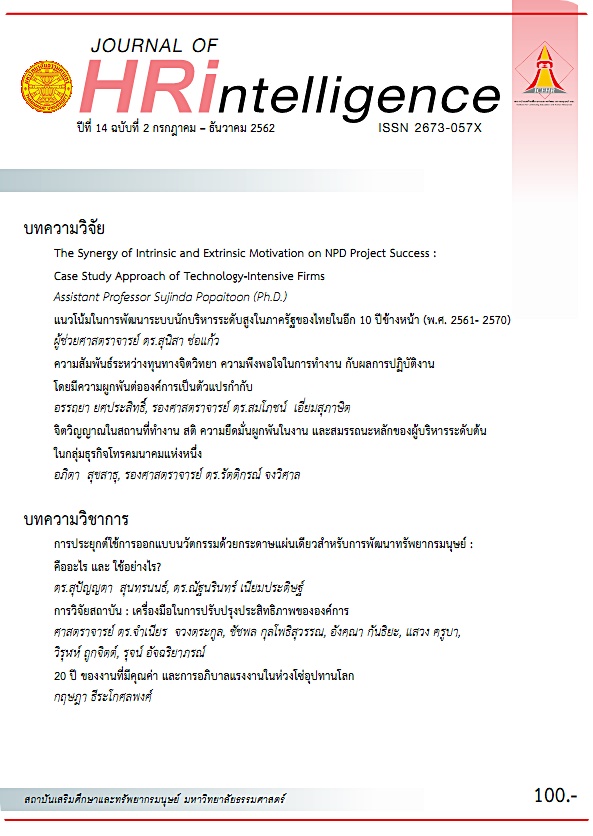The relationship between psychological capital, job satisfaction and performance: The moderating effect of organizational commitment
Main Article Content
Abstract
The relationship between psychological capital, job satisfaction, and performance was studied, with organizational commitment as moderator. Samples were 142 sales officers in a food and beverage company in the Bangkok Metropolitan Area (BMA). Data was collected by questionnaires. Personal factors, psychological capital with Cronbach’s Alpha at .955, job satisfaction with Cronbach’s Alpha at .912, organizational commitment with Cronbach’s Alpha at .899 were measured, and official yearly performance appraised. Data was analyzed by Pearson product-moment correlation coefficient (PPMCC) and hierarchical multiple regression. Results were that psychological capital and job satisfaction positively correlated with performance at a .01 level (r = .372, r = .620). Organizational commitment moderated the relationship between job satisfaction and performance (β = .148, ∆R2 = .024) but did not between psychological capital and performance.
Article Details
ขอมอบลิขสิทธิ์บทความที่ได้รับการตีพิมพ์ให้แก่สถาบันเสริมศึกษาและทรัพยากรมนุษย์ กรณีมีการฟ้องร้องเรื่องการละเมิดลิขสิทธิ์เกี่ยวกับภาพ กราฟ ข้อความส่วนใดส่วนหนึ่ง และ/หรือข้อคิดเห็นที่ปรากฎในบทความ ให้เป็นความรับผิดชอบของข้าพเจ้าและผู้เขียนร่วมแต่เพียงผู้เดียว
References
Allen, N. J., & Meyer, J. P. (1990). The measurement and antecedents of affective, continuance and normative commitment to the organization. Journal of Occupational Psychology, 63, 1-18.
Avey, J. B., Reichard, R. J., Luthans, F., & Mhatre, K. H. (2011). Meta-analysis of the impact of positive psychological capital on employee attitudes, behaviors, and performance. Human Resource Development Quarterly, 22, 127-152.
Bakker, A. B., & Oerlemans, W. (2011). Subjective well-being in organization. In K. S. Cameron & G. M. Spreitzer (Eds.), The Oxford handbook of positive organizational scholarship (pp. 178-189). New York : Oxford University Press.
Baron, R. M., & Kenny, D. A. (1986). The moderator-mediator variable distinction in social psychological research : Conceptual, strategic, and statistical considerations. Journal or Personality and Social Psychology, 51 (6), 1173-1182.
Bovee, C. L. (1993). Management. New York : McGraw-Hill.
Buchanan, B. (1974). Building organizational commitment : The socialization of managers in work organizations. Administrative Science Quarterly, 19, 533-546.
Campbell, J. P., McCloy, R. A., Oppler, S. H., & Sager, C. E. (1993). A theory of performance. In N. Schmitt & W. C. Borman (Eds.), Personnel selection in organizations (pp. 35-70). San Francisco: Jossey-Bass.
Chatabud, B. (2014). The relationship between organizational commitment and organizational citizenship behavior of public organizations employee in Bangkok ; The moderator effect of job satisfaction. Master's thesis, Thammasat University.
Eslami, J., & Gharakhani, D. (2012). Organizational commitment and job satisfaction. Journal of Science and Technology, 2 (2), 85-91.
Feinstein, A. H., & Vondrasek, D. (2001). A study of relationships between job satisfaction and organizational commitment among restaurant employees. Journal of Hospitality, Tourism, and Leisure Science, 1 (4), 1-20.
Gaertner, S. (1999). Structural determinants of job satisfaction and organizational commitment in turnover models. Human Resource Management Review, 9 (4), 479-93.
Guilford, J. P., & Fruchter, B. (1978). Fundamental statistics in psychology and education. Retrieved from http:// www.watpon.in.th/table/pearson.pdf
Hewitt Associates. (2004). Employee engagement higher at double-digit growth companies. Retrieved from http:// www.hewitt.com/doubledigitgrowth
Jacobs, R., & Solomon, T. (1977). Strategies for enhancing the prediction of job performance from job satisfaction. Journal of Applied Psychology, 62 (4), 417-421.
Jernigan, I. E., Beggs, J. M., & Kohut, G. F. (2002). Dimensions of work satisfaction as predictors of commitment type. Journal of Managerial Psychology, 17 (7), 564-579.
Kongchan, A. (1986). Organizational commitment. Chulalongkorn Business Review, 9 (34), 34-41.
Larson, M., & Luthans, F. (2006). Potential added value of psychological capital in predicting work attitudes. Journal of Leadership and Organizational Study, 13 (1), 45-62.
Lok, P., & Crawford, J. (2001). Antecedents of organizational commitment and the mediating role of job satisfaction. Journal of Managerial Psychology, 16 (8), 594-613.
Luthans, F., Youssef, M., & Avolio, B. (2007). Psychological capital : Developing the human competitive edge. Oxford, England : Oxford University Press.
Luthans, F., & Youssef, C. M. (2004). Human, social, and now positive psychological capital management :
Investing in people for competitive advantage. Organizational Dynamics, 33 (2), 143-160.
Luthans, F., Avolio, B. J., Avey, J. B., & Norman, S. M. (2007). Positive psychological capital : Measurement and relationship with performance and satisfaction. Personnel Psychology, 60, 541-572.
Luthans, F., Avolio, B. J., Walumbwa, F. O., & Li, W. (2005). The psychological capital of Chinese workers : Exploring the relationship with performance. Management and Organization Review, 1 (2), 249-271.
Michael, R. (2002). Attitudinal organizational commitment and job performance : A meta-analysis. Journal of Organizational Behavior, 23 (3), 257-266.
Mowday, R., Porter, L., & Steers, R. (1982). Employee-organization linkages : The psychology of commitment absenteeism and turnover. New York : Academic Press.
Mowday, R., Steers, R., & Porter, L. (1979). The measure of organizational commitment. Journal of Vocational Behaviour, 14 (2), 224-247.
Siripanich, R. (1990). Principles of test construction in psychology and education. Bangkok : Charoenwit.
Spector, P. (1985). Measurement of human service staff satisfaction : Development of the job satisfaction survey. American Journal of Community Psychology, 13, 693-713.
Steer, R. M. (1977). Antecedents and outcomes of organizational commitment. Administrative Science Quarterly, 22 (1), 46-56.
Werner, J. M. (1994). Dimensions that make a difference: Examining the impact of in-role and extra-role behaviors on supervisory ratings. Journal of Applied Psychology, 79 (1), 98-107.
Williams, L. J., & Hazer, J. T. (1986). Antecedents and consequences of satisfaction and commitment in turnover models : A re-analysis using latent variable structural equation methods. Journal of Applied Psychology, 71, 219-231.
Withey, M. J., & Cooper, W. H. (1989). Predicting exit, voice, loyalty, and neglect. Administrative Science Quarterly, 34 (4), 521-539.
Youssef, C. M., & Luthans, F. (2007). Positive organizational behavior in the workplace : The impact of hope, optimism, and resilience. Journal of Management, 33 (5), 774-800.


